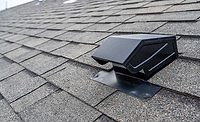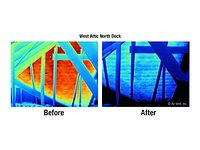Point/Counter Point on Attic Ventilation
.jpg?1633012046)
Photo credit: northlightimages/E+ via Getty Images
Homeowners are very likely to have questions about a roof replacement estimate as submitted by a roofing contractor. This includes the attic ventilation portion of the estimate. During the Q&A session of our seminars across North America, contractors frequently ask that we roleplay responses to typical homeowner questions — especially when an improvement or needed fix to the attic ventilation is involved.
Daniel White, roofing consultant at Roof Life of Oregon in Tigard, Ore., walked us through a point/counterpoint roleplay in a recent episode of our podcast. Here is a portion of that conversation. For simplicity, we assumed the homeowner understands a new roof is needed. It’s the attic ventilation line items within the estimate being questioned by the homeowner.
POINT: Why Change the Attic Exhaust Vents?
Homeowner: “You have a section here called ‘attic ventilation’ and I see listed something called ‘ridge vent’ and there is also ‘soffit vents’ listed. I already have three or four wind turbines on my roof. Why don’t you just give me brand new wind turbines since that’s what’s already up there?”
Roofing Contractor: “There’s several reasons we want to replace the wind turbines with ridge vent when we do your roof. First, as they age, wind turbines can start to make noise as they spin. My father has wind turbines on his roof, and they are starting to squeak. Plus, wind turbines leave dead pockets inside the attic space in which the air is not moving because they are spaced apart on the roof. Anywhere there is not a wind turbine the air cannot flow very well. Third, when you look at wind turbines on your roof, what do you see? You see these great big R2-D2 heads near the peak of your roof.
"When we put a ridge vent system on your roof, we’re going to go all the way across the entire roofline of your house. It’s a low-profile vent as you can see in this picture, so it blends nicely with your roof. It’s a much cleaner look. And, we have no dead air spots inside the attic. Air is able to exit from the entire attic through the ridge vent. That airflow allows the removal of heat and moisture from your attic year-round.”
Homeowner: “So my wind turbines have been leaving dead air spaces all these years in my attic?”
Roofing Contractor: “That’s correct. And it’s not just wind turbines that do that. Your neighbors across the street have box vents. Just like wind turbines, box vents are spaced out along the roof. Wherever there is a space between the box vents the air simply cannot move as well. Ridge vent allows continuous airflow. And that’s in conjunction with the intake vents listed in the estimate that will be installed in your soffit.”
POINT: If Ridge Vents are Better, Why Don’t I See More?
Homeowner: “As I look around at the houses in my neighborhood, every roof either has wind turbines or box vents. And their roofs look pretty good in terms of their condition. If ridge vents are that much better why don’t I see them on the houses around here?”
Roofing Contractor: “That’s a really good question. I don’t know why more roofing contractors are not installing ridge vent. Would you believe it actually costs more money to install box vents or wind turbines compared to a ridge vent system? For every box vent or wind turbine installed, the contractor has to cut in shingles around each vent. With a ridge vent system, it’s a continuous cut into the roof at the peak, we install the vent all along the peak of the roof, and we install shingles directly on top of the vent. It looks better. It performs better. And it’s a less expensive installation.
“I believe in ridge vents so much, I switched to ridge vents when my roof was replaced a year ago. I used to have box vents — that’s what the builder installed, and I did not have nearly enough box vents — and now I have switched to ridge vent.”
Homeowner: “What will the ridge vent look like on my new roof? Do you have photos you can show me?”
Roofing Contractor: “Yes, here are some photos of past installations you can look at. This photo here is my house actually. And when your roof is complete, we’ll make a short video of how it looks. As you can see in these pictures, ridge vent gives a nice clean look. We’re taking all of those individual parts and pieces – those vents – off of your roof and replacing them with one continuous vent system. Notice in the photos that we’ve installed the ridge vent along the entire length of the roof peak even though the actual hole for the vent stops short of the end of the roof. We install the vent the entire distance for a very streamlined appearance.
“It’s important that I point out there are a variety of types of ridge vents. We’re going to use a ridge vent that has an external wind baffle. That’s this wing-looking piece on the ridge vent you can see in this photograph. The external wind baffle runs along the entire edge of both sides of the ridge vent. When the wind hits that external baffle it pushes up and over the vent creating low pressure, which actually helps to pull more air out of the attic. The name for this is the Bernoulli Effect. It’s creating low pressure. It’s what makes an airplane fly.
“If the ridge vent does not have this external wind baffle, when the wind comes across and hits your roof, it can actually cause your ridge vent to ingest air and not work the way it’s supposed to. But if you have that wing to the outside edges of the ridge vent, the wind comes across, hits that wing, pushes the wind up and over the vent — again, that’s the Bernoulli Effect causing low pressure — and it makes your ridge vent work better without ingesting any air, rain or snow.”
POINT: Will My New Roof Last Longer if I Switch to Ridge Vents?
Homeowner: “If we make this switch from wind turbines to ridge vent are you saying my new roof will last longer than the roof I have now lasted?”
Roofing Contractor: “That is the goal. And I will tell you every shingle manufacturer warranty tells you in writing if you don’t put your roof to current building code when it comes to attic ventilation they can and will void your warranty. So let’s say you put the new roof on and in 10-15 years all of the granules start falling off the roof. It could be a manufacturer defect. However, if the shingle manufacturer comes out to inspect your roof and the attic ventilation is not good, they can say, ‘Sorry, your ventilation is no good. Your warranty is void.’ And I have seen it happen.”
Homeowner: “So the ridge vent helps ensure I’ll meet the attic ventilation requirements and thus protect my warranty?”
Roofing Contractor: “That’s correct. And that’s in conjunction with the intake vents listed in the estimate.”
POINT: Why are You Recommending So Many More Intake Vents?
Homeowner: “You have listed in the estimate that I need 18 undereave vents each 16-inch by 8-inch. I counted what I have around the house before you arrived, and I already have 10 of those undereave vents. Do I really need 18?”
Roofing Contractor: “Yes, you do. We want your attic ventilation to be a balanced system. Whatever you have at the top of your roof for exhaust we want to match that at the bottom for intake along the entire perimeter of the house — 50% exhaust and 50% intake airflow.
“I like to use the analogy of a funnel. Let’s say another roofing contractor installs ridge vent on your new roof but does not increase the intake vents. The ridge vent is the top of the funnel, the big opening. At the bottom is the small opening of your current intake ventilation. You roof is breathing through a straw. So I don’t care what you do to the top of the roof, if you don’t match the bottom to the top in terms of airflow, you’ll always have a funnel instead of a cylinder. Your roof and attic will be starving for air. By having a balanced system of intake and exhaust the funnel changes to a cylinder with even flow of air. And that’s your best chance to fight heat and moisture buildup inside the attic.”
Looking for a reprint of this article?
From high-res PDFs to custom plaques, order your copy today!





